Taxation Theory, Practice and Law: Emmi and Liu's Tax Analysis Report
VerifiedAdded on 2023/01/13
|9
|2523
|58
Report
AI Summary
This report provides a detailed analysis of the taxation implications for two individuals, Emmi and Liu, under Australian tax law. The first part examines Emmi's income tax liabilities, including assessable income from restaurant work and tips, and the application of fringe benefits tax on entertainment events. It explores relevant sections of the ITAA 36 and the Fringe Benefits Tax Assessment Act 1986, focusing on deductions and exemptions. The report calculates Emmi's taxable income and tax payable, considering her gift from her father. The second part delves into Liu's capital gains tax (CGT) obligations. It covers exemptions for residential property sold before 1985, personal assets like cars and furniture, and active business assets. The analysis includes specific CGT concessions for small businesses and the treatment of collectibles like paintings. The report concludes by summarizing the tax outcomes for both individuals based on the provided scenarios and relevant tax provisions.
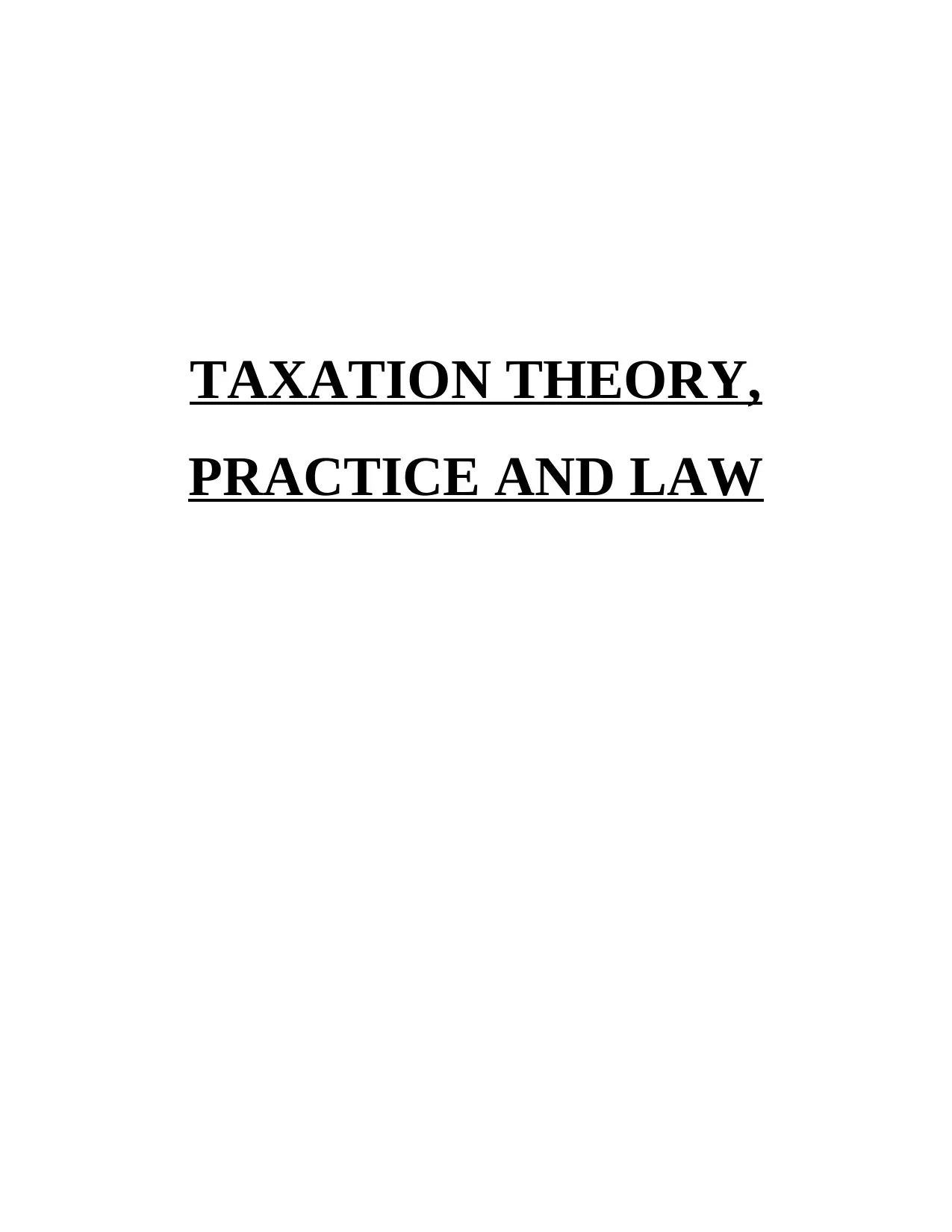
TAXATION THEORY,
PRACTICE AND LAW
PRACTICE AND LAW
Paraphrase This Document
Need a fresh take? Get an instant paraphrase of this document with our AI Paraphraser
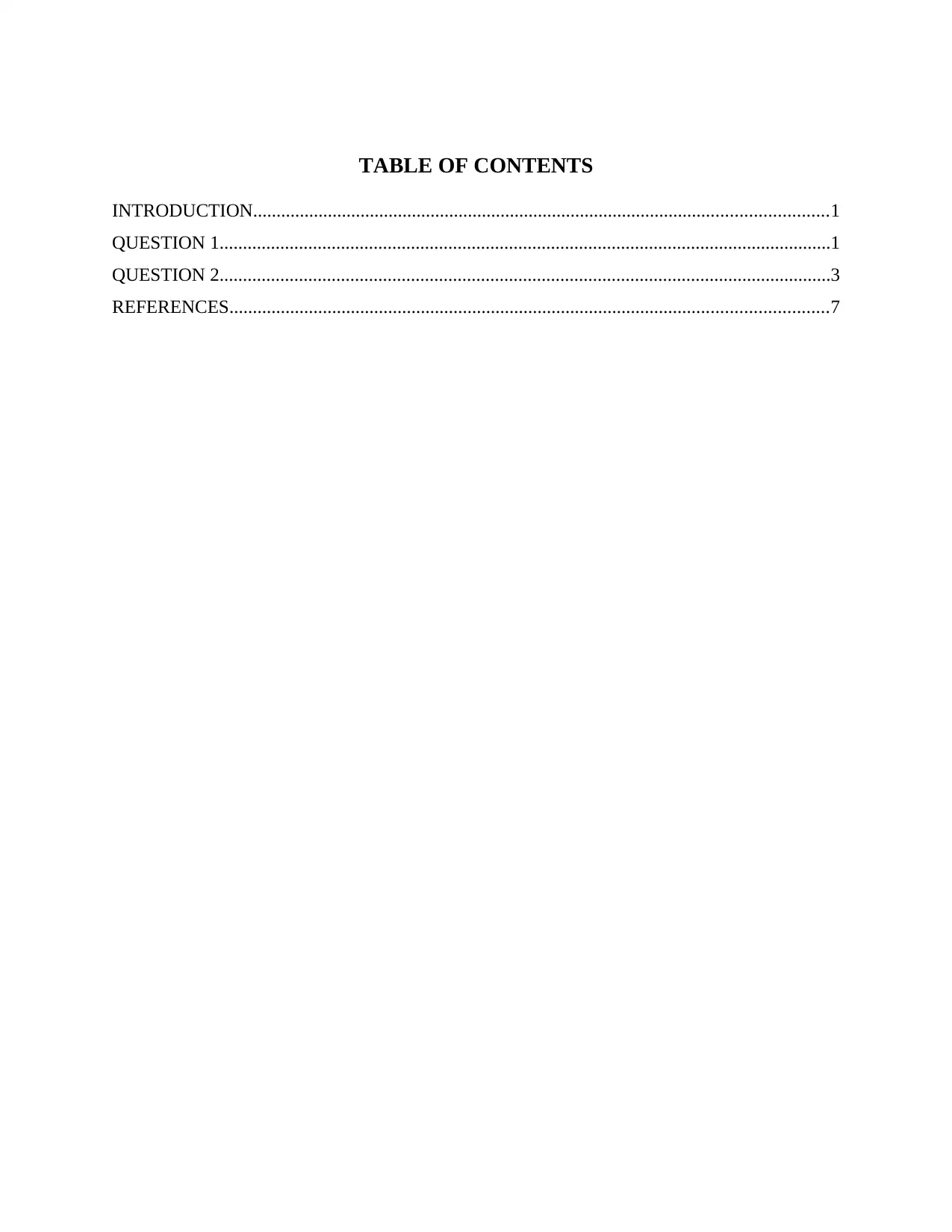
TABLE OF CONTENTS
INTRODUCTION...........................................................................................................................1
QUESTION 1...................................................................................................................................1
QUESTION 2...................................................................................................................................3
REFERENCES................................................................................................................................7
INTRODUCTION...........................................................................................................................1
QUESTION 1...................................................................................................................................1
QUESTION 2...................................................................................................................................3
REFERENCES................................................................................................................................7
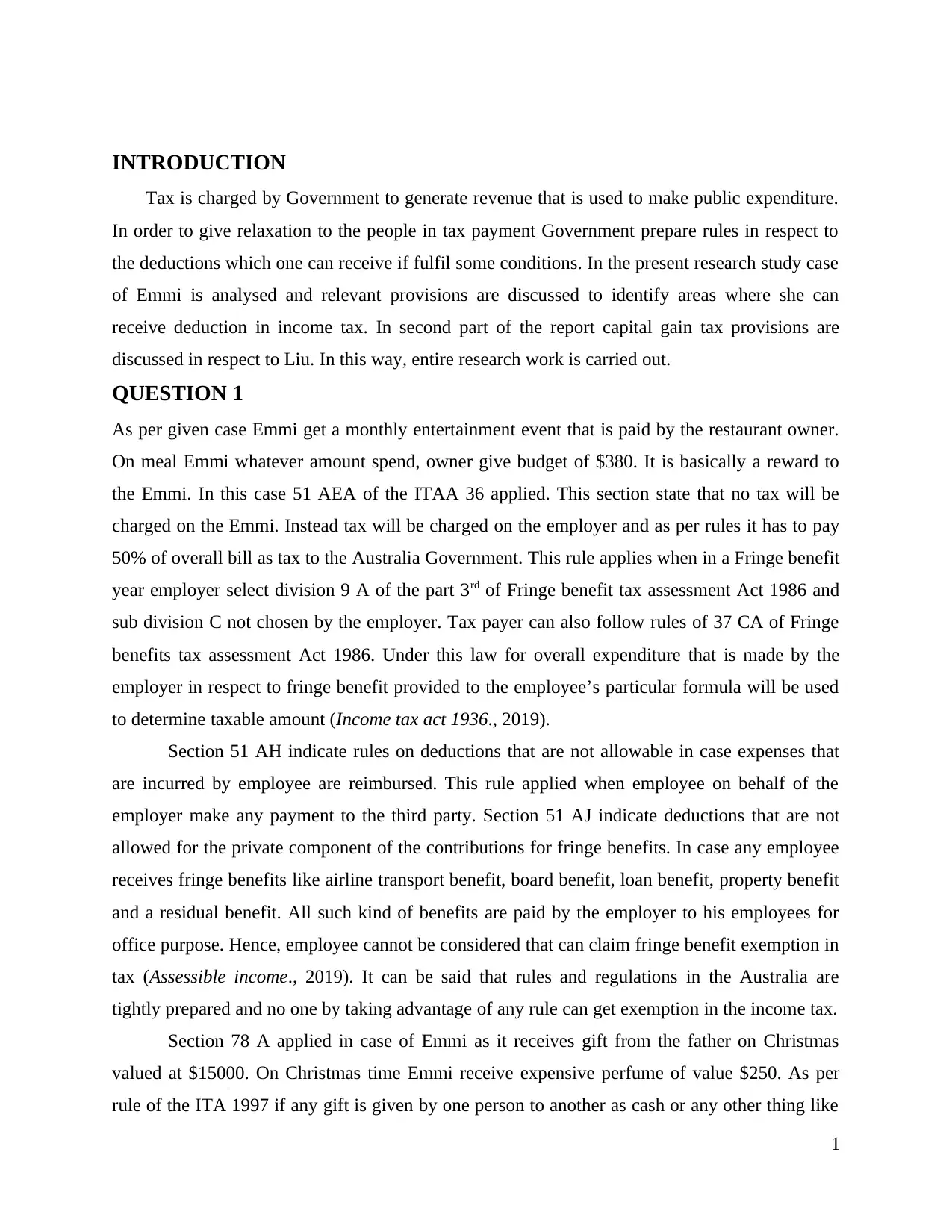
INTRODUCTION
Tax is charged by Government to generate revenue that is used to make public expenditure.
In order to give relaxation to the people in tax payment Government prepare rules in respect to
the deductions which one can receive if fulfil some conditions. In the present research study case
of Emmi is analysed and relevant provisions are discussed to identify areas where she can
receive deduction in income tax. In second part of the report capital gain tax provisions are
discussed in respect to Liu. In this way, entire research work is carried out.
QUESTION 1
As per given case Emmi get a monthly entertainment event that is paid by the restaurant owner.
On meal Emmi whatever amount spend, owner give budget of $380. It is basically a reward to
the Emmi. In this case 51 AEA of the ITAA 36 applied. This section state that no tax will be
charged on the Emmi. Instead tax will be charged on the employer and as per rules it has to pay
50% of overall bill as tax to the Australia Government. This rule applies when in a Fringe benefit
year employer select division 9 A of the part 3rd of Fringe benefit tax assessment Act 1986 and
sub division C not chosen by the employer. Tax payer can also follow rules of 37 CA of Fringe
benefits tax assessment Act 1986. Under this law for overall expenditure that is made by the
employer in respect to fringe benefit provided to the employee’s particular formula will be used
to determine taxable amount (Income tax act 1936., 2019).
Section 51 AH indicate rules on deductions that are not allowable in case expenses that
are incurred by employee are reimbursed. This rule applied when employee on behalf of the
employer make any payment to the third party. Section 51 AJ indicate deductions that are not
allowed for the private component of the contributions for fringe benefits. In case any employee
receives fringe benefits like airline transport benefit, board benefit, loan benefit, property benefit
and a residual benefit. All such kind of benefits are paid by the employer to his employees for
office purpose. Hence, employee cannot be considered that can claim fringe benefit exemption in
tax (Assessible income., 2019). It can be said that rules and regulations in the Australia are
tightly prepared and no one by taking advantage of any rule can get exemption in the income tax.
Section 78 A applied in case of Emmi as it receives gift from the father on Christmas
valued at $15000. On Christmas time Emmi receive expensive perfume of value $250. As per
rule of the ITA 1997 if any gift is given by one person to another as cash or any other thing like
1
Tax is charged by Government to generate revenue that is used to make public expenditure.
In order to give relaxation to the people in tax payment Government prepare rules in respect to
the deductions which one can receive if fulfil some conditions. In the present research study case
of Emmi is analysed and relevant provisions are discussed to identify areas where she can
receive deduction in income tax. In second part of the report capital gain tax provisions are
discussed in respect to Liu. In this way, entire research work is carried out.
QUESTION 1
As per given case Emmi get a monthly entertainment event that is paid by the restaurant owner.
On meal Emmi whatever amount spend, owner give budget of $380. It is basically a reward to
the Emmi. In this case 51 AEA of the ITAA 36 applied. This section state that no tax will be
charged on the Emmi. Instead tax will be charged on the employer and as per rules it has to pay
50% of overall bill as tax to the Australia Government. This rule applies when in a Fringe benefit
year employer select division 9 A of the part 3rd of Fringe benefit tax assessment Act 1986 and
sub division C not chosen by the employer. Tax payer can also follow rules of 37 CA of Fringe
benefits tax assessment Act 1986. Under this law for overall expenditure that is made by the
employer in respect to fringe benefit provided to the employee’s particular formula will be used
to determine taxable amount (Income tax act 1936., 2019).
Section 51 AH indicate rules on deductions that are not allowable in case expenses that
are incurred by employee are reimbursed. This rule applied when employee on behalf of the
employer make any payment to the third party. Section 51 AJ indicate deductions that are not
allowed for the private component of the contributions for fringe benefits. In case any employee
receives fringe benefits like airline transport benefit, board benefit, loan benefit, property benefit
and a residual benefit. All such kind of benefits are paid by the employer to his employees for
office purpose. Hence, employee cannot be considered that can claim fringe benefit exemption in
tax (Assessible income., 2019). It can be said that rules and regulations in the Australia are
tightly prepared and no one by taking advantage of any rule can get exemption in the income tax.
Section 78 A applied in case of Emmi as it receives gift from the father on Christmas
valued at $15000. On Christmas time Emmi receive expensive perfume of value $250. As per
rule of the ITA 1997 if any gift is given by one person to another as cash or any other thing like
1
⊘ This is a preview!⊘
Do you want full access?
Subscribe today to unlock all pages.

Trusted by 1+ million students worldwide
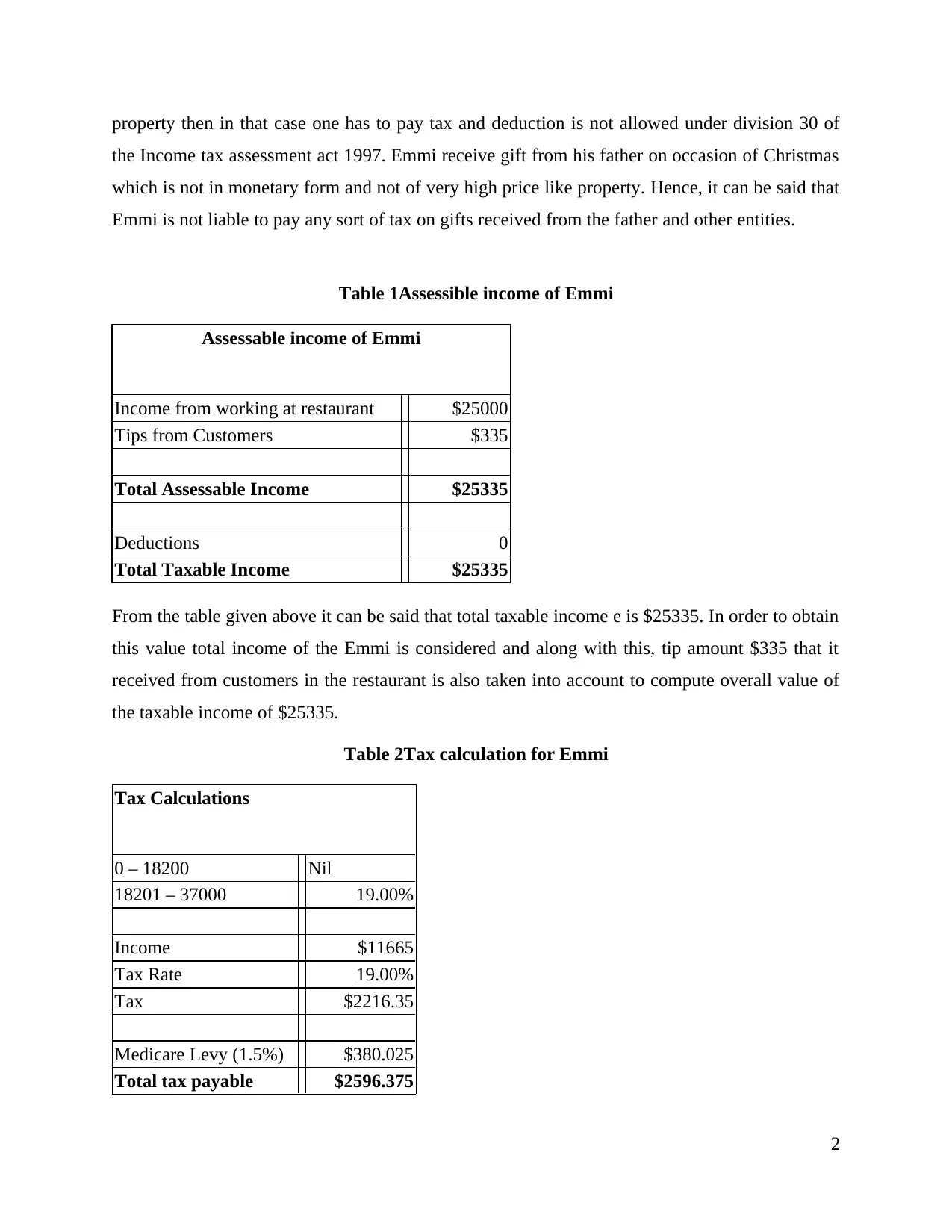
property then in that case one has to pay tax and deduction is not allowed under division 30 of
the Income tax assessment act 1997. Emmi receive gift from his father on occasion of Christmas
which is not in monetary form and not of very high price like property. Hence, it can be said that
Emmi is not liable to pay any sort of tax on gifts received from the father and other entities.
Table 1Assessible income of Emmi
Assessable income of Emmi
Income from working at restaurant $25000
Tips from Customers $335
Total Assessable Income $25335
Deductions 0
Total Taxable Income $25335
From the table given above it can be said that total taxable income e is $25335. In order to obtain
this value total income of the Emmi is considered and along with this, tip amount $335 that it
received from customers in the restaurant is also taken into account to compute overall value of
the taxable income of $25335.
Table 2Tax calculation for Emmi
Tax Calculations
0 – 18200 Nil
18201 – 37000 19.00%
Income $11665
Tax Rate 19.00%
Tax $2216.35
Medicare Levy (1.5%) $380.025
Total tax payable $2596.375
2
the Income tax assessment act 1997. Emmi receive gift from his father on occasion of Christmas
which is not in monetary form and not of very high price like property. Hence, it can be said that
Emmi is not liable to pay any sort of tax on gifts received from the father and other entities.
Table 1Assessible income of Emmi
Assessable income of Emmi
Income from working at restaurant $25000
Tips from Customers $335
Total Assessable Income $25335
Deductions 0
Total Taxable Income $25335
From the table given above it can be said that total taxable income e is $25335. In order to obtain
this value total income of the Emmi is considered and along with this, tip amount $335 that it
received from customers in the restaurant is also taken into account to compute overall value of
the taxable income of $25335.
Table 2Tax calculation for Emmi
Tax Calculations
0 – 18200 Nil
18201 – 37000 19.00%
Income $11665
Tax Rate 19.00%
Tax $2216.35
Medicare Levy (1.5%) $380.025
Total tax payable $2596.375
2
Paraphrase This Document
Need a fresh take? Get an instant paraphrase of this document with our AI Paraphraser
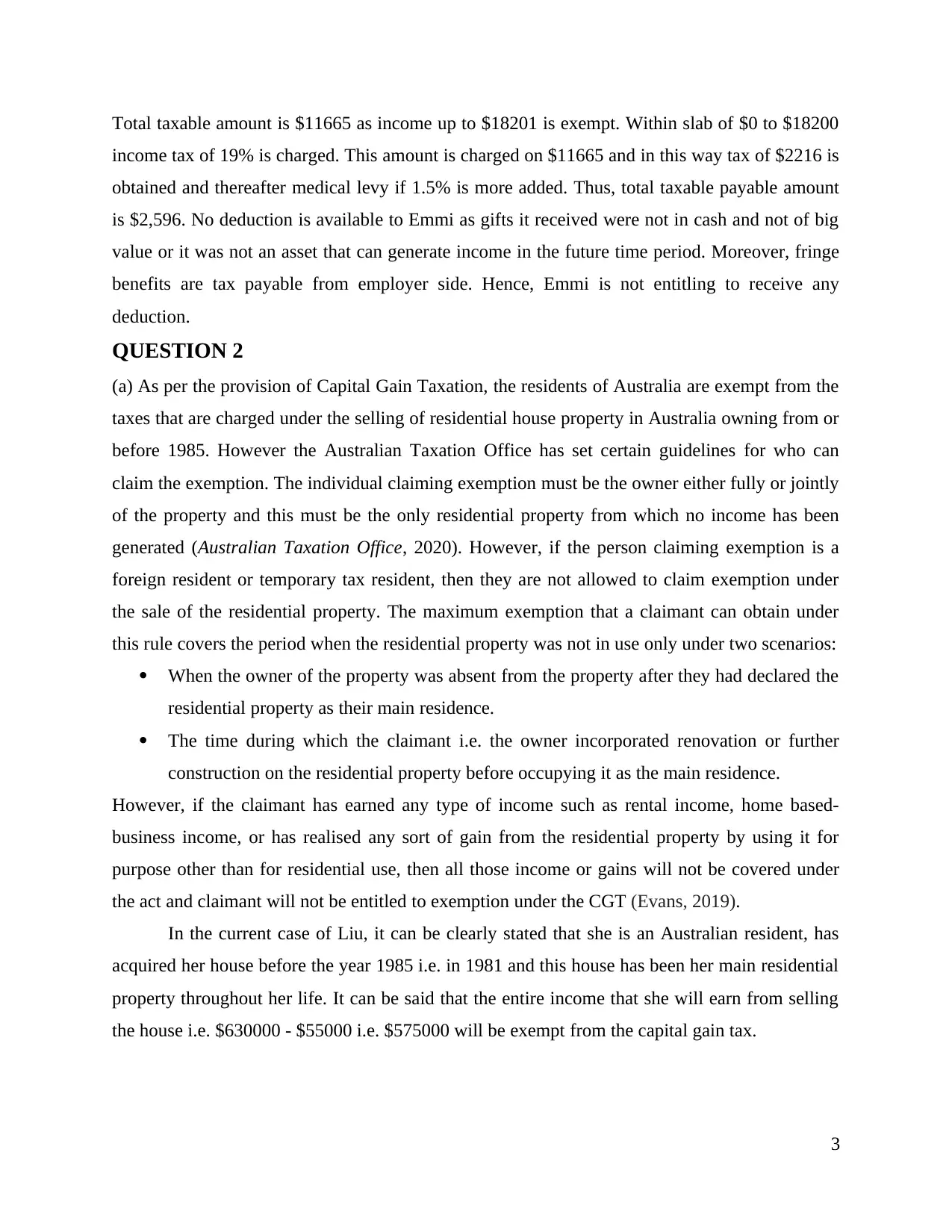
Total taxable amount is $11665 as income up to $18201 is exempt. Within slab of $0 to $18200
income tax of 19% is charged. This amount is charged on $11665 and in this way tax of $2216 is
obtained and thereafter medical levy if 1.5% is more added. Thus, total taxable payable amount
is $2,596. No deduction is available to Emmi as gifts it received were not in cash and not of big
value or it was not an asset that can generate income in the future time period. Moreover, fringe
benefits are tax payable from employer side. Hence, Emmi is not entitling to receive any
deduction.
QUESTION 2
(a) As per the provision of Capital Gain Taxation, the residents of Australia are exempt from the
taxes that are charged under the selling of residential house property in Australia owning from or
before 1985. However the Australian Taxation Office has set certain guidelines for who can
claim the exemption. The individual claiming exemption must be the owner either fully or jointly
of the property and this must be the only residential property from which no income has been
generated (Australian Taxation Office, 2020). However, if the person claiming exemption is a
foreign resident or temporary tax resident, then they are not allowed to claim exemption under
the sale of the residential property. The maximum exemption that a claimant can obtain under
this rule covers the period when the residential property was not in use only under two scenarios:
When the owner of the property was absent from the property after they had declared the
residential property as their main residence.
The time during which the claimant i.e. the owner incorporated renovation or further
construction on the residential property before occupying it as the main residence.
However, if the claimant has earned any type of income such as rental income, home based-
business income, or has realised any sort of gain from the residential property by using it for
purpose other than for residential use, then all those income or gains will not be covered under
the act and claimant will not be entitled to exemption under the CGT (Evans, 2019).
In the current case of Liu, it can be clearly stated that she is an Australian resident, has
acquired her house before the year 1985 i.e. in 1981 and this house has been her main residential
property throughout her life. It can be said that the entire income that she will earn from selling
the house i.e. $630000 - $55000 i.e. $575000 will be exempt from the capital gain tax.
3
income tax of 19% is charged. This amount is charged on $11665 and in this way tax of $2216 is
obtained and thereafter medical levy if 1.5% is more added. Thus, total taxable payable amount
is $2,596. No deduction is available to Emmi as gifts it received were not in cash and not of big
value or it was not an asset that can generate income in the future time period. Moreover, fringe
benefits are tax payable from employer side. Hence, Emmi is not entitling to receive any
deduction.
QUESTION 2
(a) As per the provision of Capital Gain Taxation, the residents of Australia are exempt from the
taxes that are charged under the selling of residential house property in Australia owning from or
before 1985. However the Australian Taxation Office has set certain guidelines for who can
claim the exemption. The individual claiming exemption must be the owner either fully or jointly
of the property and this must be the only residential property from which no income has been
generated (Australian Taxation Office, 2020). However, if the person claiming exemption is a
foreign resident or temporary tax resident, then they are not allowed to claim exemption under
the sale of the residential property. The maximum exemption that a claimant can obtain under
this rule covers the period when the residential property was not in use only under two scenarios:
When the owner of the property was absent from the property after they had declared the
residential property as their main residence.
The time during which the claimant i.e. the owner incorporated renovation or further
construction on the residential property before occupying it as the main residence.
However, if the claimant has earned any type of income such as rental income, home based-
business income, or has realised any sort of gain from the residential property by using it for
purpose other than for residential use, then all those income or gains will not be covered under
the act and claimant will not be entitled to exemption under the CGT (Evans, 2019).
In the current case of Liu, it can be clearly stated that she is an Australian resident, has
acquired her house before the year 1985 i.e. in 1981 and this house has been her main residential
property throughout her life. It can be said that the entire income that she will earn from selling
the house i.e. $630000 - $55000 i.e. $575000 will be exempt from the capital gain tax.
3
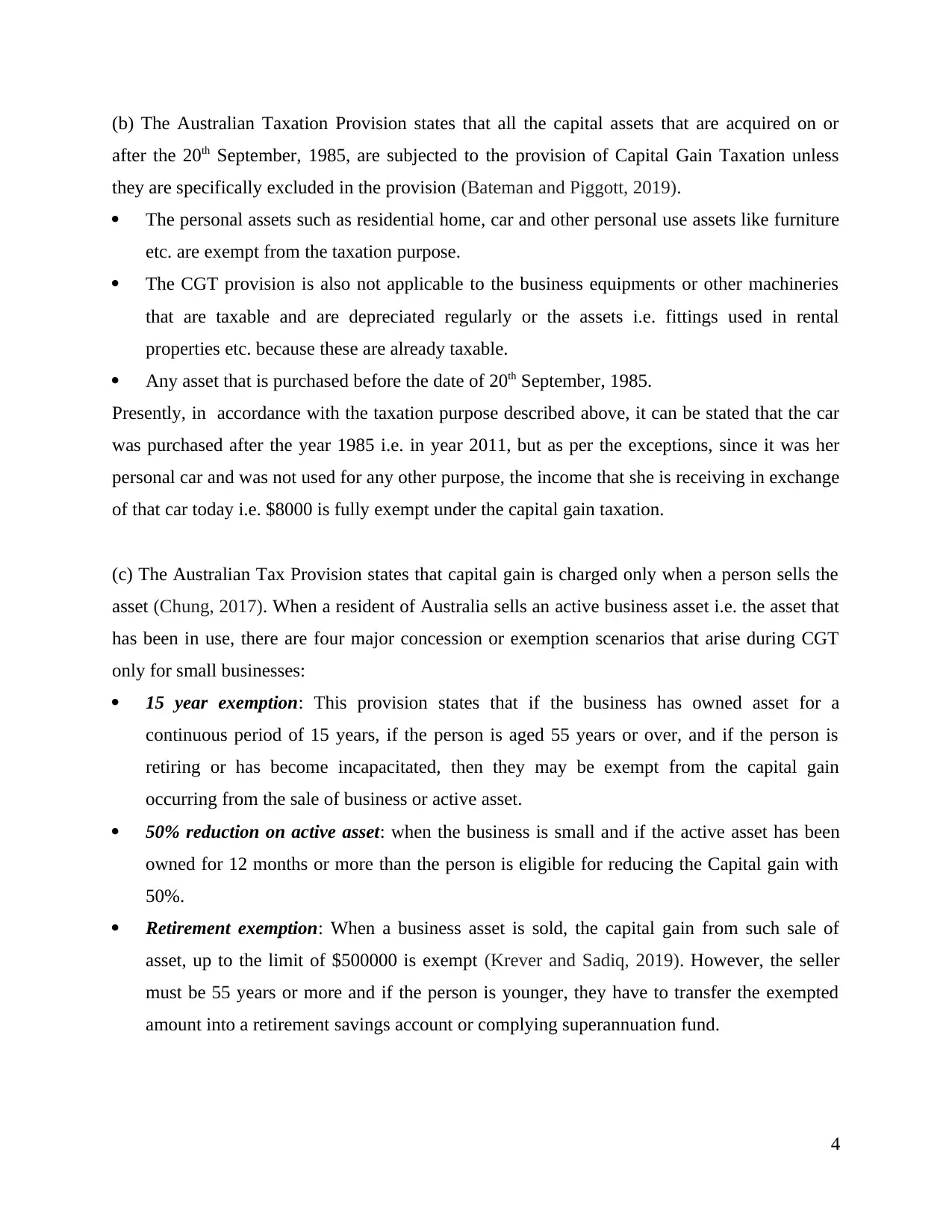
(b) The Australian Taxation Provision states that all the capital assets that are acquired on or
after the 20th September, 1985, are subjected to the provision of Capital Gain Taxation unless
they are specifically excluded in the provision (Bateman and Piggott, 2019).
The personal assets such as residential home, car and other personal use assets like furniture
etc. are exempt from the taxation purpose.
The CGT provision is also not applicable to the business equipments or other machineries
that are taxable and are depreciated regularly or the assets i.e. fittings used in rental
properties etc. because these are already taxable.
Any asset that is purchased before the date of 20th September, 1985.
Presently, in accordance with the taxation purpose described above, it can be stated that the car
was purchased after the year 1985 i.e. in year 2011, but as per the exceptions, since it was her
personal car and was not used for any other purpose, the income that she is receiving in exchange
of that car today i.e. $8000 is fully exempt under the capital gain taxation.
(c) The Australian Tax Provision states that capital gain is charged only when a person sells the
asset (Chung, 2017). When a resident of Australia sells an active business asset i.e. the asset that
has been in use, there are four major concession or exemption scenarios that arise during CGT
only for small businesses:
15 year exemption: This provision states that if the business has owned asset for a
continuous period of 15 years, if the person is aged 55 years or over, and if the person is
retiring or has become incapacitated, then they may be exempt from the capital gain
occurring from the sale of business or active asset.
50% reduction on active asset: when the business is small and if the active asset has been
owned for 12 months or more than the person is eligible for reducing the Capital gain with
50%.
Retirement exemption: When a business asset is sold, the capital gain from such sale of
asset, up to the limit of $500000 is exempt (Krever and Sadiq, 2019). However, the seller
must be 55 years or more and if the person is younger, they have to transfer the exempted
amount into a retirement savings account or complying superannuation fund.
4
after the 20th September, 1985, are subjected to the provision of Capital Gain Taxation unless
they are specifically excluded in the provision (Bateman and Piggott, 2019).
The personal assets such as residential home, car and other personal use assets like furniture
etc. are exempt from the taxation purpose.
The CGT provision is also not applicable to the business equipments or other machineries
that are taxable and are depreciated regularly or the assets i.e. fittings used in rental
properties etc. because these are already taxable.
Any asset that is purchased before the date of 20th September, 1985.
Presently, in accordance with the taxation purpose described above, it can be stated that the car
was purchased after the year 1985 i.e. in year 2011, but as per the exceptions, since it was her
personal car and was not used for any other purpose, the income that she is receiving in exchange
of that car today i.e. $8000 is fully exempt under the capital gain taxation.
(c) The Australian Tax Provision states that capital gain is charged only when a person sells the
asset (Chung, 2017). When a resident of Australia sells an active business asset i.e. the asset that
has been in use, there are four major concession or exemption scenarios that arise during CGT
only for small businesses:
15 year exemption: This provision states that if the business has owned asset for a
continuous period of 15 years, if the person is aged 55 years or over, and if the person is
retiring or has become incapacitated, then they may be exempt from the capital gain
occurring from the sale of business or active asset.
50% reduction on active asset: when the business is small and if the active asset has been
owned for 12 months or more than the person is eligible for reducing the Capital gain with
50%.
Retirement exemption: When a business asset is sold, the capital gain from such sale of
asset, up to the limit of $500000 is exempt (Krever and Sadiq, 2019). However, the seller
must be 55 years or more and if the person is younger, they have to transfer the exempted
amount into a retirement savings account or complying superannuation fund.
4
⊘ This is a preview!⊘
Do you want full access?
Subscribe today to unlock all pages.

Trusted by 1+ million students worldwide
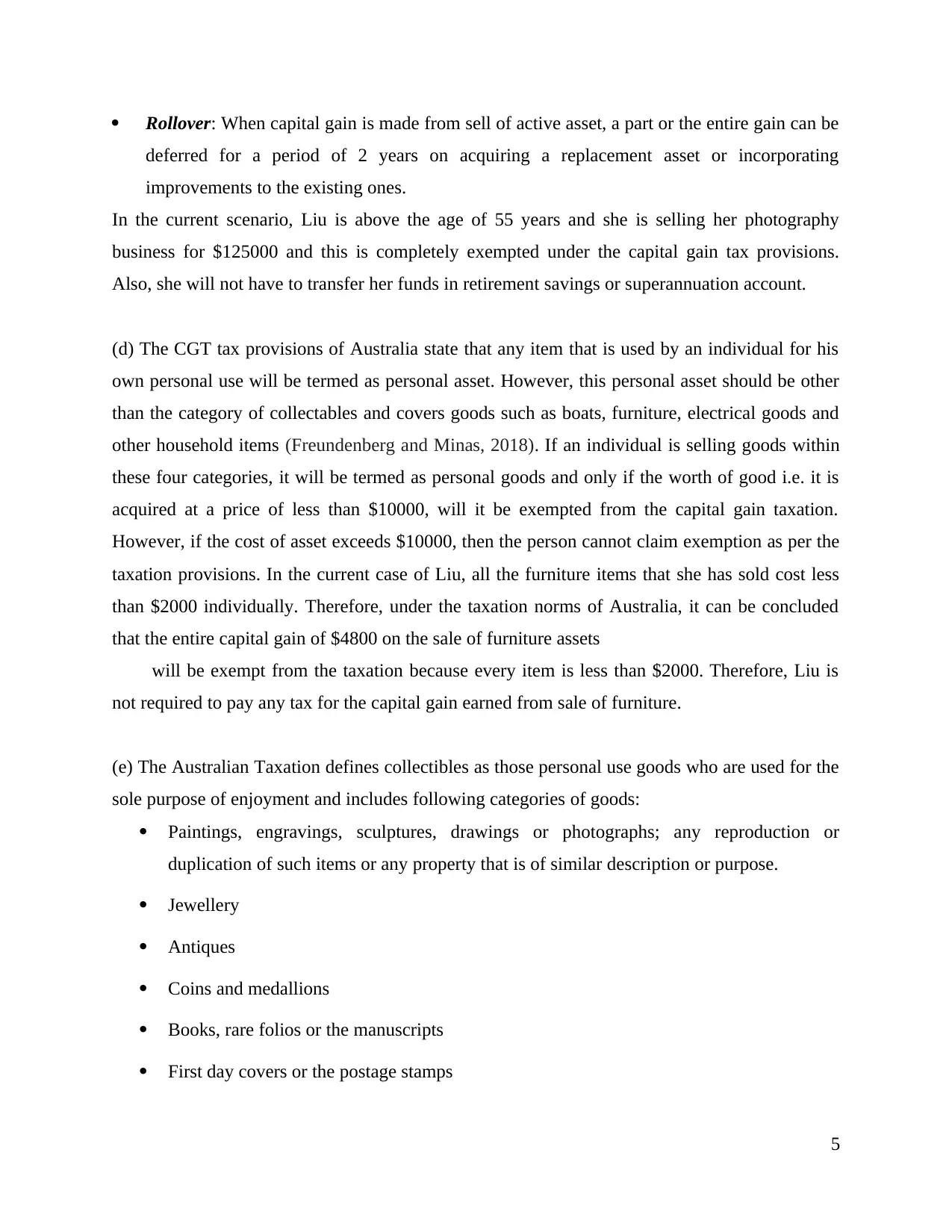
Rollover: When capital gain is made from sell of active asset, a part or the entire gain can be
deferred for a period of 2 years on acquiring a replacement asset or incorporating
improvements to the existing ones.
In the current scenario, Liu is above the age of 55 years and she is selling her photography
business for $125000 and this is completely exempted under the capital gain tax provisions.
Also, she will not have to transfer her funds in retirement savings or superannuation account.
(d) The CGT tax provisions of Australia state that any item that is used by an individual for his
own personal use will be termed as personal asset. However, this personal asset should be other
than the category of collectables and covers goods such as boats, furniture, electrical goods and
other household items (Freundenberg and Minas, 2018). If an individual is selling goods within
these four categories, it will be termed as personal goods and only if the worth of good i.e. it is
acquired at a price of less than $10000, will it be exempted from the capital gain taxation.
However, if the cost of asset exceeds $10000, then the person cannot claim exemption as per the
taxation provisions. In the current case of Liu, all the furniture items that she has sold cost less
than $2000 individually. Therefore, under the taxation norms of Australia, it can be concluded
that the entire capital gain of $4800 on the sale of furniture assets
will be exempt from the taxation because every item is less than $2000. Therefore, Liu is
not required to pay any tax for the capital gain earned from sale of furniture.
(e) The Australian Taxation defines collectibles as those personal use goods who are used for the
sole purpose of enjoyment and includes following categories of goods:
Paintings, engravings, sculptures, drawings or photographs; any reproduction or
duplication of such items or any property that is of similar description or purpose.
Jewellery
Antiques
Coins and medallions
Books, rare folios or the manuscripts
First day covers or the postage stamps
5
deferred for a period of 2 years on acquiring a replacement asset or incorporating
improvements to the existing ones.
In the current scenario, Liu is above the age of 55 years and she is selling her photography
business for $125000 and this is completely exempted under the capital gain tax provisions.
Also, she will not have to transfer her funds in retirement savings or superannuation account.
(d) The CGT tax provisions of Australia state that any item that is used by an individual for his
own personal use will be termed as personal asset. However, this personal asset should be other
than the category of collectables and covers goods such as boats, furniture, electrical goods and
other household items (Freundenberg and Minas, 2018). If an individual is selling goods within
these four categories, it will be termed as personal goods and only if the worth of good i.e. it is
acquired at a price of less than $10000, will it be exempted from the capital gain taxation.
However, if the cost of asset exceeds $10000, then the person cannot claim exemption as per the
taxation provisions. In the current case of Liu, all the furniture items that she has sold cost less
than $2000 individually. Therefore, under the taxation norms of Australia, it can be concluded
that the entire capital gain of $4800 on the sale of furniture assets
will be exempt from the taxation because every item is less than $2000. Therefore, Liu is
not required to pay any tax for the capital gain earned from sale of furniture.
(e) The Australian Taxation defines collectibles as those personal use goods who are used for the
sole purpose of enjoyment and includes following categories of goods:
Paintings, engravings, sculptures, drawings or photographs; any reproduction or
duplication of such items or any property that is of similar description or purpose.
Jewellery
Antiques
Coins and medallions
Books, rare folios or the manuscripts
First day covers or the postage stamps
5
Paraphrase This Document
Need a fresh take? Get an instant paraphrase of this document with our AI Paraphraser
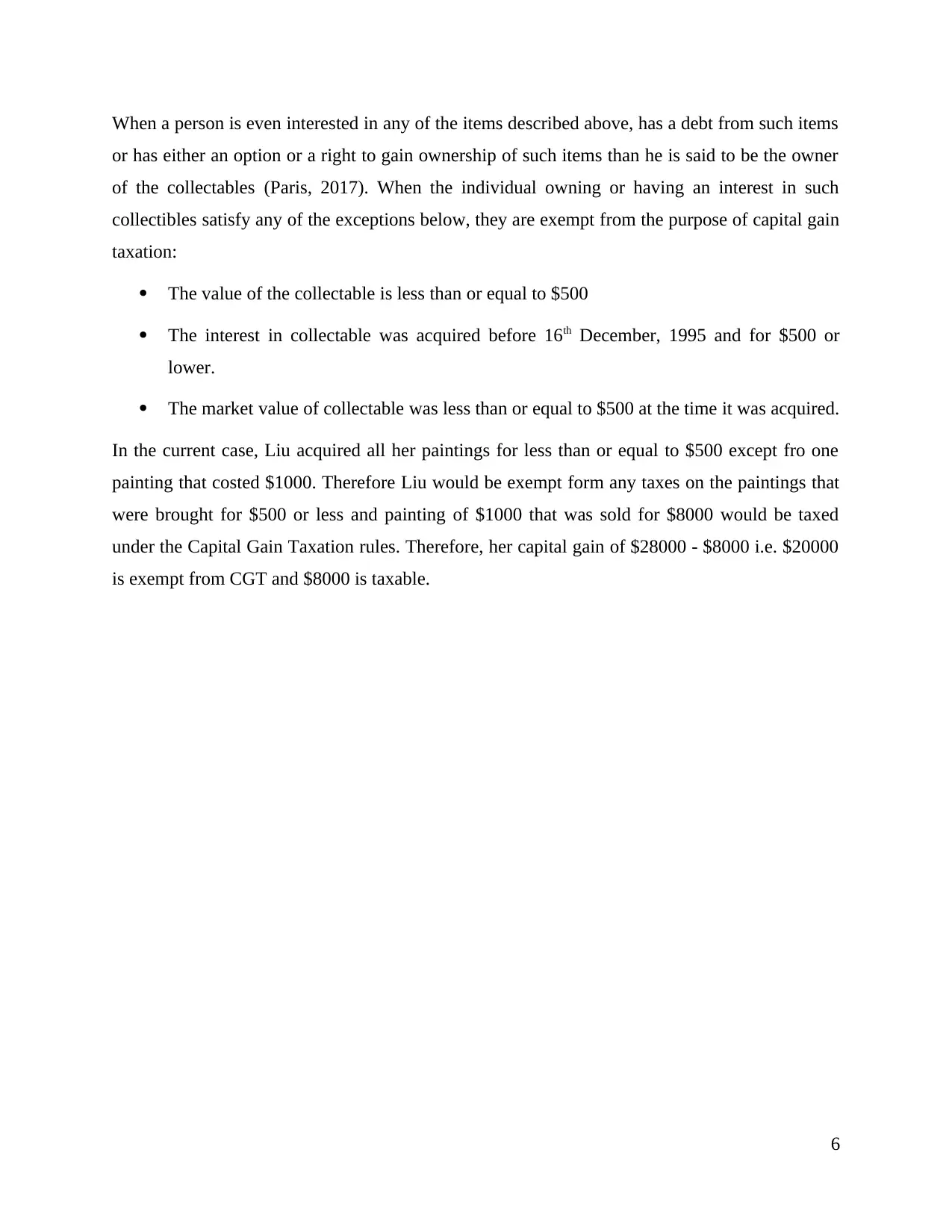
When a person is even interested in any of the items described above, has a debt from such items
or has either an option or a right to gain ownership of such items than he is said to be the owner
of the collectables (Paris, 2017). When the individual owning or having an interest in such
collectibles satisfy any of the exceptions below, they are exempt from the purpose of capital gain
taxation:
The value of the collectable is less than or equal to $500
The interest in collectable was acquired before 16th December, 1995 and for $500 or
lower.
The market value of collectable was less than or equal to $500 at the time it was acquired.
In the current case, Liu acquired all her paintings for less than or equal to $500 except fro one
painting that costed $1000. Therefore Liu would be exempt form any taxes on the paintings that
were brought for $500 or less and painting of $1000 that was sold for $8000 would be taxed
under the Capital Gain Taxation rules. Therefore, her capital gain of $28000 - $8000 i.e. $20000
is exempt from CGT and $8000 is taxable.
6
or has either an option or a right to gain ownership of such items than he is said to be the owner
of the collectables (Paris, 2017). When the individual owning or having an interest in such
collectibles satisfy any of the exceptions below, they are exempt from the purpose of capital gain
taxation:
The value of the collectable is less than or equal to $500
The interest in collectable was acquired before 16th December, 1995 and for $500 or
lower.
The market value of collectable was less than or equal to $500 at the time it was acquired.
In the current case, Liu acquired all her paintings for less than or equal to $500 except fro one
painting that costed $1000. Therefore Liu would be exempt form any taxes on the paintings that
were brought for $500 or less and painting of $1000 that was sold for $8000 would be taxed
under the Capital Gain Taxation rules. Therefore, her capital gain of $28000 - $8000 i.e. $20000
is exempt from CGT and $8000 is taxable.
6
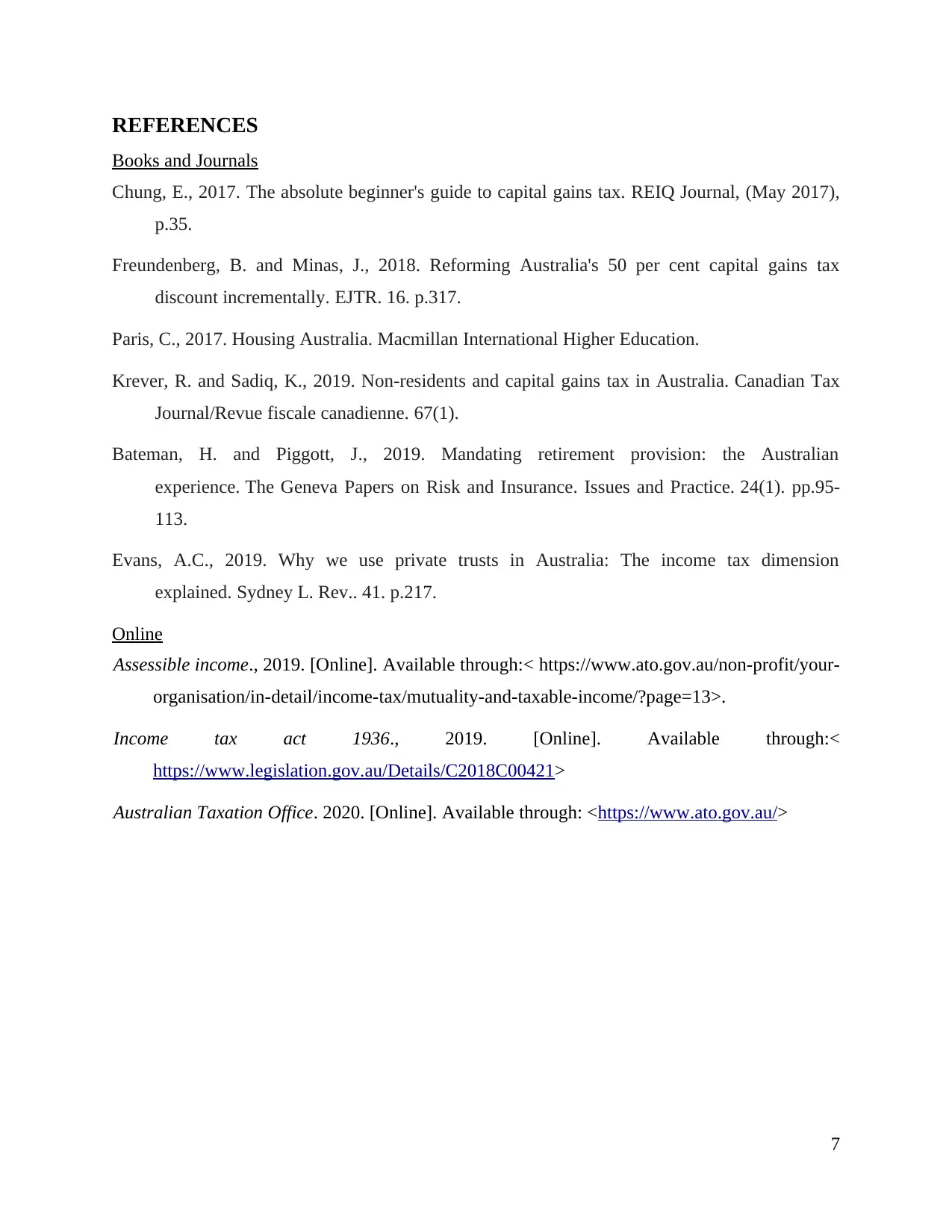
REFERENCES
Books and Journals
Chung, E., 2017. The absolute beginner's guide to capital gains tax. REIQ Journal, (May 2017),
p.35.
Freundenberg, B. and Minas, J., 2018. Reforming Australia's 50 per cent capital gains tax
discount incrementally. EJTR. 16. p.317.
Paris, C., 2017. Housing Australia. Macmillan International Higher Education.
Krever, R. and Sadiq, K., 2019. Non-residents and capital gains tax in Australia. Canadian Tax
Journal/Revue fiscale canadienne. 67(1).
Bateman, H. and Piggott, J., 2019. Mandating retirement provision: the Australian
experience. The Geneva Papers on Risk and Insurance. Issues and Practice. 24(1). pp.95-
113.
Evans, A.C., 2019. Why we use private trusts in Australia: The income tax dimension
explained. Sydney L. Rev.. 41. p.217.
Online
Assessible income., 2019. [Online]. Available through:< https://www.ato.gov.au/non-profit/your-
organisation/in-detail/income-tax/mutuality-and-taxable-income/?page=13>.
Income tax act 1936., 2019. [Online]. Available through:<
https://www.legislation.gov.au/Details/C2018C00421>
Australian Taxation Office. 2020. [Online]. Available through: <https://www.ato.gov.au/>
7
Books and Journals
Chung, E., 2017. The absolute beginner's guide to capital gains tax. REIQ Journal, (May 2017),
p.35.
Freundenberg, B. and Minas, J., 2018. Reforming Australia's 50 per cent capital gains tax
discount incrementally. EJTR. 16. p.317.
Paris, C., 2017. Housing Australia. Macmillan International Higher Education.
Krever, R. and Sadiq, K., 2019. Non-residents and capital gains tax in Australia. Canadian Tax
Journal/Revue fiscale canadienne. 67(1).
Bateman, H. and Piggott, J., 2019. Mandating retirement provision: the Australian
experience. The Geneva Papers on Risk and Insurance. Issues and Practice. 24(1). pp.95-
113.
Evans, A.C., 2019. Why we use private trusts in Australia: The income tax dimension
explained. Sydney L. Rev.. 41. p.217.
Online
Assessible income., 2019. [Online]. Available through:< https://www.ato.gov.au/non-profit/your-
organisation/in-detail/income-tax/mutuality-and-taxable-income/?page=13>.
Income tax act 1936., 2019. [Online]. Available through:<
https://www.legislation.gov.au/Details/C2018C00421>
Australian Taxation Office. 2020. [Online]. Available through: <https://www.ato.gov.au/>
7
⊘ This is a preview!⊘
Do you want full access?
Subscribe today to unlock all pages.

Trusted by 1+ million students worldwide
1 out of 9
Related Documents
Your All-in-One AI-Powered Toolkit for Academic Success.
+13062052269
info@desklib.com
Available 24*7 on WhatsApp / Email
![[object Object]](/_next/static/media/star-bottom.7253800d.svg)
Unlock your academic potential
Copyright © 2020–2025 A2Z Services. All Rights Reserved. Developed and managed by ZUCOL.





